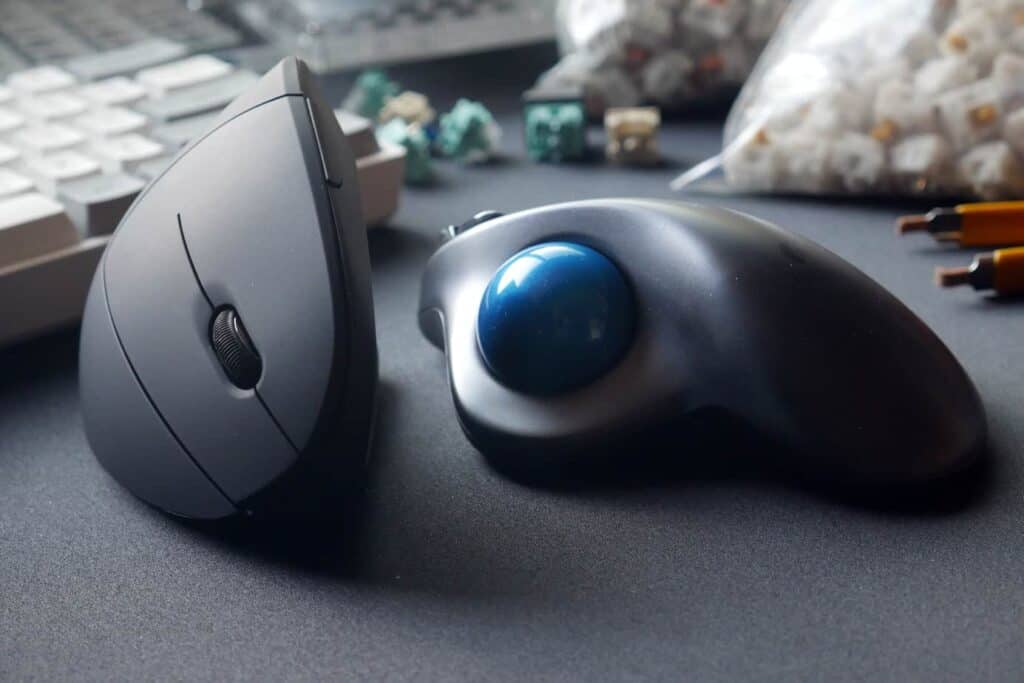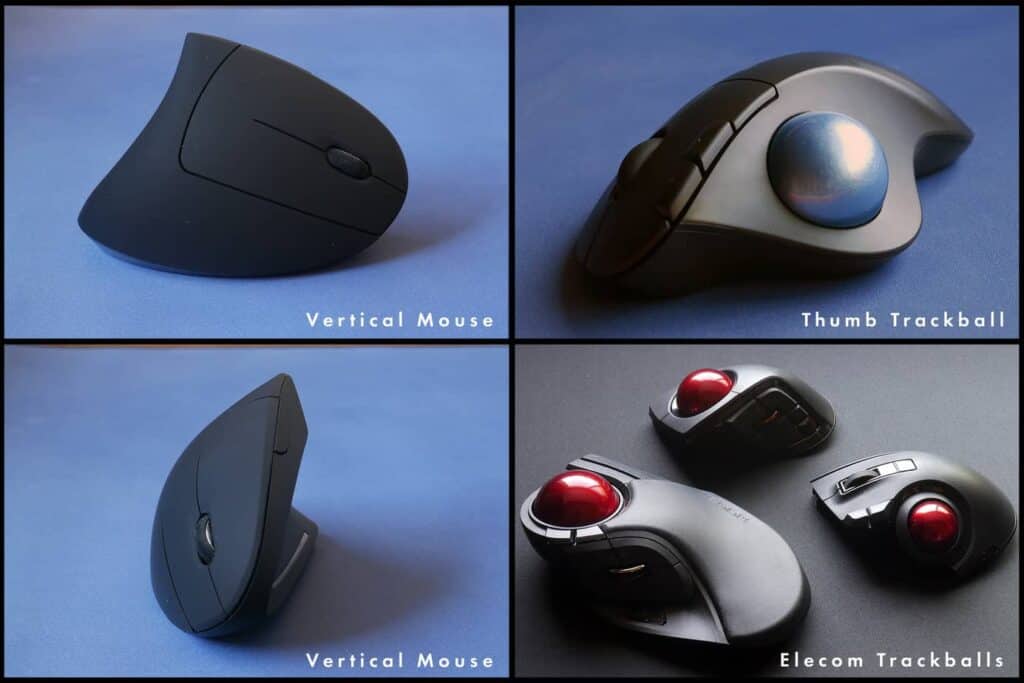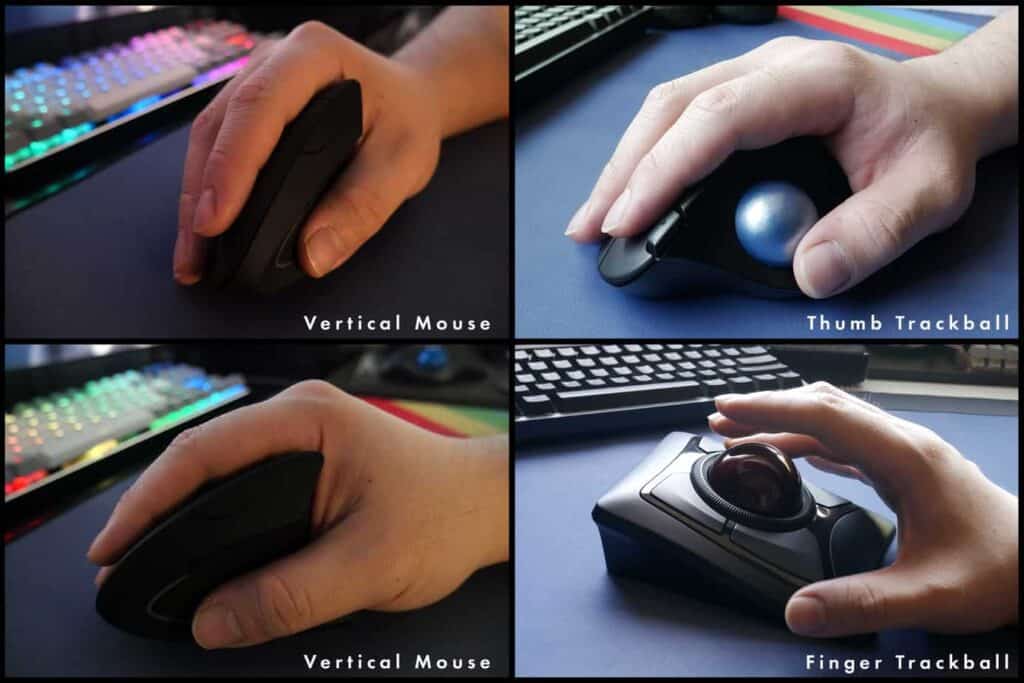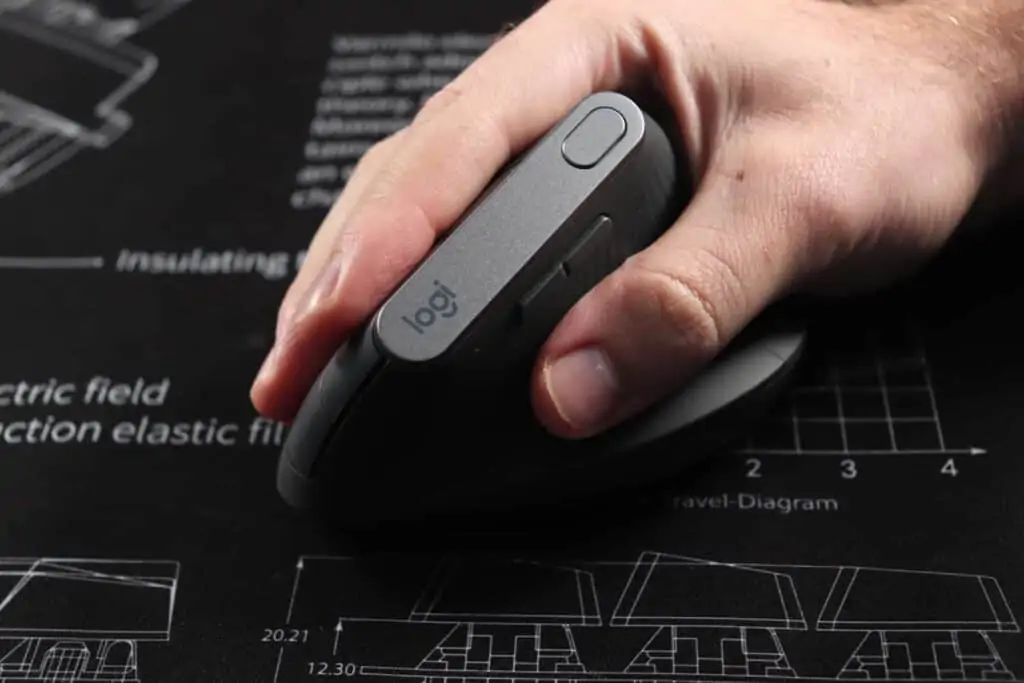After years, after decades of using a regular mouse, you start to ask yourself: “What else is out there?”
If you’re considering a mouse alternative, the roads lead to vertical mice and trackballs.
Should you go up the path of comfort, or choose to roll down an unfamiliar road less travelled?
Let’s see the differences in each path to see which you should follow.
The Major Differences Between A Vertical Mouse and Trackball

| Vertical Mouse | Trackball Mouse |
|---|---|
| Hand position more vertical | Hand position varies |
| Hand moves mouse around desk | Fingers move ball over sensor |
| Best with Palm or Claw Grip | Allows for variety of grips |
| Less productivity, more ergonomics | More productivity, less ergonomics |
| Easier to try for mouse users | Takes getting used to |
| Weight reduces smoothness | Rough bearings reduce smoothness |
When it comes to the mouse alternatives, the two more popular choices are vertical mice and trackballs.
A vertical mouse is essentially a normal mouse tilted on its side, so people looking for a quick and easy adjustment period will prefer the vertical mouse.
An ideal ergonomic option for those suffering from thumb pain, wrist pain, and RSI, the vertical mouse focuses on ergonomics first.
By prioritizing hand placement and position, vertical mice provide comfortable and healthy mouse-movements under ideal conditions.
A trackball mouse may not be as comfortable or easy to use at first, but after a short adjustment period trackballs make up for it with productivity and convenience.
Trackballs save on deskspace, reduce arm and shoulder movement, and allow for ambidextrous use.
Though your hand may be more pronated than with a vertical mouse, trackballs will make use of your hand and fingers more efficiently as well.
Which one should you choose? Let’s examine these two mice and see which one is right for you.
Design and Build Quality

Generally speaking, vertical mice and trackballs have the same relative build quality at a given price point.
There inherent differences in each mouse design which contribute to their overall build quality, however, including weight, size, and shape.
Vertical Mice are light and ergonomic
Vertical mice, like traditional mice, depend on light weights and smooth skates to glide across your desk smoothly and effortlessly.
Vertical mice also tend to have taller shapes that are ergonomically designed to fit within your hand while in a “natural handshake position”.
Tilting the mouse to a vertical position means you wont have the “downward force” necesaary to control a vertical mouse like you would a traditionally shaped mouse.
Ergonomic designs mean that typically, left-handed users will have a hard time finding the right choice.
Trackball Mice are heavy and efficient
Trackball mice on the other hand benefit from heavier housings because they are stationary mice.
More weight means more quality and less likelihood of the trackball moving around on your desk.
Trackballs come in multiple shapes and sizes, mainly based on whether it is a thumb or finger operated trackball, ball diameter, and where the ball is mounted.
Trackballs are also offered in ambidextrous and lefty designs, and some may have more buttons to increase productivity and efficiency.
Grip Type and Hand Position

How you hold a mouse is crucial for comfort and ease-of-use.
Traditional mice usually allow for a variety of mouse grips including palm grip, claw grip, fingertip grip, and hybrid positions.
The issue comes from “over-pronation”, or having your palm face flat.
This can cause your forearm bones to cross over and overlap, and in turn puts pressure and stress on the local nerves.
Vertical mice and trackballs look to correct these issues in different ways.
Vertical Mice fight over-pronation
Vertical mice aim for your hand to rest in a “natural handshake position” which limits pronation.
The vertical position and size also limits the viability of “fingertip grip” for smaller hands.
Without downward force and gravity working in your favor when it comes to clicking and controlling the mouse, fingertip grip becomes more unstable with a vertical mouse.
“Palm” and modified “claw” grips work well for most hands, especially if your thumb is angled and placed lower on the mouse to allow for more downward force and control.
Vertical mice tend to solve the issue of over-pronation and thumb strain.
Trackballs fight convention
Trackballs aim for minimal movement in your arm, elbow, and shoulder.
Some trackballs do allow for very vertical positions, such as the MX Ergo Plus and Kensington Pro Fit Ergo, but these are usually limited to thumb-operated right-handed trackballs.
Trackballs give you the option of using your thumb or fingers to operate the ball, and which you choose will determine which grips you can use.
Side-mounted thumbballs tend to allow for all three grips to be used, and everything in between, due to having a traditional button layout.
Top-mounted fingerballs tend to force you into a specific grip type, but ambidextrous control.
As trackballs are stationary, the ease of use will be related to the shape of the device and smoothness of the bearings.
Trackballs tend to solve the issue of stretching too far from center.
The Ideal Gaming Mouse
Finding the right mouse and mouse-grip are crucial when it comes to comfortable and reliable gaming.
Which mouse and grip you choose will typically relate to your playstyle and character role; this includes aiming, flicking, and weapon technique.
Vertical mice are better for arm-aimers
Can you game with a vertical mouse? Of course, but you have to find the right grip first.
Vertical mice tend to work best with palm and claw grips.
Like we’ve established above, this tends to be because of a lack of downward force needed for control and stability, especially while aiming and clicking.
Both arm and wrist aiming are possible, but using your wrist may feel strange at first if you aren’t used to a more ergonomic mouse.
Palm grip and arm-aiming, especially for snipers and hit-scan players, will feel just as natural on a vertical mouse.
Flicking may seem awkward at first, but is easier with lighter vertical mice. The vertical orientation may make flicking feel fatiguing for your wrist. Arm/elbow flickers at high sensitivity will have no issues.
Trackballs are a class of their own
Are trackballs good for gaming? Perhaps not at first.
Gaming and using a trackball in general may seem awkward if you’ve only ever used a traditional mouse.
This is especially true of top-mounted fingerballs, because you will be forced into not only using a new way of controlling the cursor, but a new button layout to get used to as well.
Side-mounted thumbballs will have no issues with layout.
Depending on sensitivity, DPI, and acceleration settings you may not get enough range of motion in your thumb to move your cursor as well as a fingerrball, vertical mouse, or traditional gaming mouse.
Flicking is very possible with fingers or thumbs.
You will essentially flick and spin the ball with more force and speed, going into “free-spin” mode.
This simulates the effect of flicking, and you will need to stop the spinning with your thumb or fingers if you overshoot.
Choosing Based On Desk Space
Gaming with a traditional mouse usually means you have to worry about deskspace.
Depending on your mouse and in-game settings, as well as playstyle, you may need a ton of deskspace to aim and move with your gaming mouse.
Vertical Mice Require More Space
The deskspace dilemma holds equally true with vertical mice, and perhaps even more, due to the vertical orientation and the range of motion it requires.
Arm aiming and general usage at a low DPI-setting will require considerable deskspace.
If you are using a keyboard without a tilt, then you may be straining your arm and shoulder by moving too far from center.
Higher DPI will be essential if you wish to minimize physical movement and maximize cursor movement.
Trackballs Are Stationary
Trackballs, on the other hand, are stationary, and won’t require you to stretch past the position you have chosen.
Your arm and shoulder will thank you, especially if you are using a full-sized keyboard.
Trackballs also allow for greater freedom in desk placement, especially if you have a wireless model.
You won’t need a special mousepad or deskmat, as the smoothness will not depend on the surface you use it on.
If you can get used to using one, a trackball proves to be an incredible solution for those with limited room for placements and movement.
Benefits/Downsides of Vertical and Trackball Mice
Vertical mice and trackballs seem to solve many problems on-paper, but they don’t come without their trade-offs.
You’ll need some time to adjust
Why do your forearm and hand muscles hurt? Because you haven’t used them before.
Most of use have used a normal mouse for years not out of choice, but because it’s what we were given. From a young (and more flexible) age, we are familiarized with the traditional mouse and how to use it.
So much so that alternative options like vertical mice and trackballs feel foreign at first.
Vertical Mice may feel clumsy at first
Vertical mice, as the name implies, tend to stand taller and more upright than normal mice, and even trackballs.
This may mean that when reaching for your mouse, you knock it over or collide into it rather than cradling the mouse.
The vertical orientation also means you must get used to clicking “into” or “toward” the mouse, and not simply “downward”.
The lack of downward force means a lack of control that we are used to, clicking may not feel natural, or may register a small drag due to horizontal movement.
Smaller hands may also have difficulty using vertical mice with certain grips, especially fingertip grip, when using a vertical mouse that tends to work better with average-to-large sized hands.
Trackballs might be painful for you
Trackball mice may just feel awkward to use, and there are very few options that are as well designed as vertical and traditional mice.
Trackball comfort may be very volatile, as usability is determined by multiple factors including hand size, trackball type, ball size, overall size, angle of the wrist, and ergonomics.
Finding a trackball that fits your needs may be more difficult and time-consuming, especially if you find a Logitech M570 to be uncomfortable.
Thumbballs tends to feel better in the hand, but may lead to thumb fatigue, strain, and even injuries like De Quervains, which attacks the overused tendons in your thumb and wrist.
While neither vertical mouse nor trackball are a bad alternative, they may not be the right fit for you.
What’s important when looking for new alternatives is that you try, and give yourself some time to adjust.
Which Mouse Should You Try?
So, should you try a vertical mouse or a trackball?
Vertical Mice are for…
If your concern is with forearm and wrist ergonomics, as well as RSI like Carpal Tunnel and De Quervain’s Tenosynovitis, you should go for a vertical mouse.
Vertical mice are not for people who are concerned about deskspace or having a productivity-driven mouse.
Arguably, the single best vertical mouse is the Logitech MX Ergo, which is a premium mouse at a premium price.
If you’re a lefty, your options are unfortunately limited.
Trackballs are for…
If your concern is deskspace, speed and precision, and productivity-driven designs, then trackballs are the choice for you.
Trackballs come in a much wider variety of designs, and although the choice may seem overwhelming, you can likely find a great fit if you are willing to adjust.
Trackballs are also an ideal choice for those who may not be able to control or use a mouse with their hands.
If you’re looking for a more vertical option, the Kensington Pro Fit Ergo is a “vertical thumbball” designed specifically to fight over-pronation, and the Logitech MX Ergo Plus allows you to adjust to a near-vertical tilt.
If you aren’t looking for a mouse that takes time to adjust to, then consider a vertical mouse, or stick with a regular mouse.
Recommended Mice

Logitech MX Vertical
Arguably the best vertical mouse on the market today, the Logitech MX Vertical is a premium device that is comfortable for all hands, and provides both Bluetooth and 2.4ghz wireless connectivity. The angle of tilt is 57 degrees.
The Logitech Unifying receivers and Flow technology allow you to use a single mouse with multiple devices, and even copy files from one to the other, provided each device has a receiver and is on the same network.
Watch Betty’s full review video here!
Get Vertical on Amazon.
Logitech MX Ergo Plus
Another premium Logitech option, the Logitech MX Ergo Plus is a thumb-operated side-mounted trackball with a secret weapon: adjustable tilt.
You are able to choose from 2 angles without the included base, up to 20 degrees.
When adding the base, however, you are able to get to 30 degrees of tilt with a bit of added height.
This level of adjustment makes the MX Ergo Plus one of the most ergonomically friendly thumbballs on the market (provided you are a righty).
Get rolling for a great price on Amazon.
Elecom Deft Pro
The Elecom Deft Pro is an ergonomic fingerball with a productivity-driven design.
With more buttons than your fingers know what to do with and three different connectivity options including wired, Bluetooth, and 2.4ghz wireless, the Elecom Deft Pro is a great choice for right-handers looking for a trackball that will help you do more.
Read the full review here.
Find the Elecom Deft Pro on Amazon.
Conclusion
Vertical Mice and Trackballs are two mouse alternatives that solve many problems, but may introduce a few of their own.
For mouse users looking to prevent RSI and improve comfort without venturing too far from tradition, the Vertical mouse presents a compelling ergonomic option.
For more adventurous users looking for a change that could improve productivity and efficienty, roll with a trackball.
Either way you choose, what is important is that you give it a chance, but don’t ignore any new pain or strain.
We hope this guide has helped you learn more about vertical and trackball mice.
Thank you for reading!
